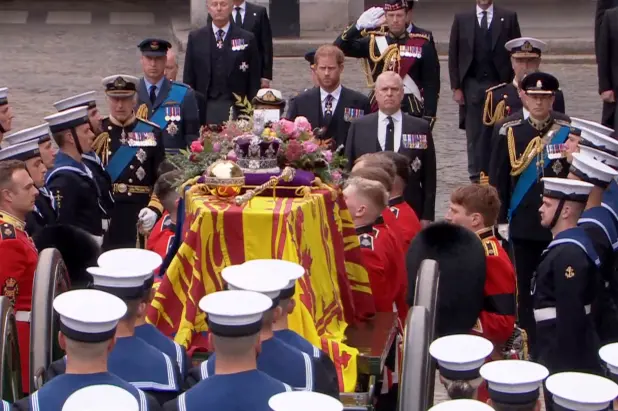Borne on an army-green gun carriage and escorted by pipers from the Scottish and Irish regiments, the coffin of Queen Elizabeth II was carried into Westminster Abbey on Monday morning for her state funeral.
It was the beginning of an extraordinary day of solemn rituals and extravagant pomp that will end on Monday evening, when the queen is laid to rest at Windsor Castle, next to her husband, Prince Philip. The service began at 11 a.m. in Westminster Abbey, with King Charles III and his family in the front row, including two of his grandchildren, Prince George, 9, and Princess Charlotte, 7.
“Here, where Queen Elizabeth was married and crowned, we gather from across the nation, from the Commonwealth and from the nations of the world,” the Rev. David Hoyle, the dean of Westminster, said to an assembly that included more than 100 world leaders, among them President Biden and Emperor Naruhito of Japan.
With the queen’s coffin before the dean, he called on those gathered “to mourn our loss, to remember her long life of selfless service, and in sure confidence to commit her to the mercy of God our maker and redeemer.”
The meticulously choreographed service included readings by Britain’s new prime minister, Liz Truss, and the secretary general of the Commonwealth, Patricia Scotland.
It is the culmination of 10 days of mourning since the queen died on Sept. 8 in Scotland — a time of unifying grief and disorienting change — and everything about the day will stretch precedents for such gatherings.
Hundreds of world leaders filled the seats in Westminster Abbey. Tens of thousands of people waited along the route the funeral cortege will take through London on a grand procession to Windsor Castle. Thousands more will await the queen at Windsor.
Britain has not held a state funeral since 1965, when it buried Winston Churchill, the wartime leader who acted as a mentor to a young Elizabeth after she unexpectedly came to the throne upon the death of her father, King George VI, in 1952.
As with every other ritual since the queen’s death, the funeral was meticulously choreographed. At 10:35 a.m., pallbearers carried the queen’s coffin from Westminster Hall, where it was viewed by tens of thousands of mourners, including Mr. Biden, to a gun carriage for the short procession to Westminster Abbey.
King Charles III and other members of the royal family walked behind the coffin, flanked by detachments of the queen’s corps of the Gentlemen at Arms, the Yeomen of the Guard and the Royal Company of Archers.
The archbishop of Canterbury, the Most Rev. Justin Welby, delivered a eulogy.
After a military bugler plays “The Last Post,” signifying the end of the service, the abbey, and the nation, will fall silent for two minutes in honor of the queen. The congregation will then sing “God Save the King” and the queen’s piper will play a lament as her coffin is lifted back onto the carriage.
From there, the cortege will begin a stately roll through the city center, retracing the route it took, in reverse, when her coffin was moved Wednesday from Buckingham Palace to Westminster Hall — a symbolic transfer of the queen, who was 96 at her death, from her family to the British state.
Unlike that stark procession, this one was choreographed to project the full splendor of the monarchy: seven groups, each with their own marching band; detachments from the Royal Canadian Mounted Police, the Royal Ulster Constabulary, and the British armed forces; and mounted soldiers from the Household Cavalry.
Soldiers will line the route from Westminster Abbey to Wellington Arch, which celebrates Britain’s victories in the Napoleonic Wars. It stands next to Hyde Park, where artillery guns will be fired during the procession and where visitors will be able to watch the proceedings on large screens.
This is also where the queen’s coffin will be transferred from the carriage to a hearse for the 25-mile journey to Windsor. Huge crowds are expected to watch as the vehicle travels past Kensington and Hammersmith in west London, before swinging south to pass the runways of Heathrow Airport. As it did last week, the airport will halt flights to keep the skies above the cortege still.
Shortly before 4 p.m., the queen’s coffin will arrive at Windsor, the turreted castle where she spent most of her final days, quarantining during the coronavirus pandemic. In April 2021, she buried Philip, her husband of 73 years, in an austere funeral at St. George’s Chapel in Windsor that was memorable for poignant images of the queen, isolated and masked, as she sat alone in a choir stall.
But this funeral will see full pomp and pageantry as the hearse rolls up the tree-lined vista known as the Long Walk. Once inside the chapel, there will be yet another service. At its end, the imperial state crown, the orb and the scepter — gleaming symbols of the monarchy — will be taken from the queen’s coffin, where they have sat since last Wednesday, and placed on the altar.
With that bit of imperial business completed, the coffin will be lowered into the royal vault, and the television cameras switched off. Her interment, next to Philip, in the King George VI Memorial Chapel, is a private ceremony for her family.
Tens of thousands of people gathered in Hyde Park to watch the service and recited the Lord’s Prayer together at the same time as the congregation in the Abbey.
The New York Times









